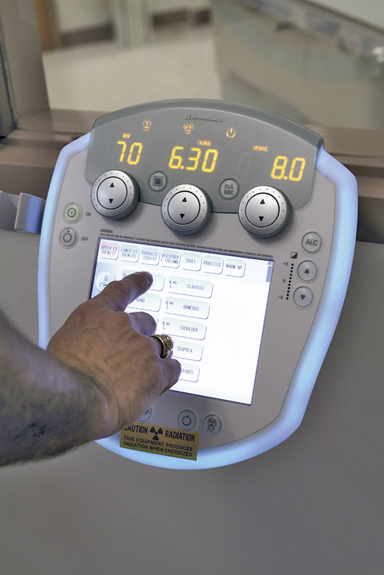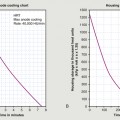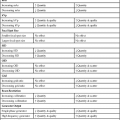• Discuss the nature of electricity in terms of electrostatics and electrodynamics. • Explain electric potential, current, and resistance. • Describe conductors and insulators and give examples of each. • Identify electronic devices important to the understanding of the x-ray circuit. • Demonstrate a basic understanding of magnetism. • Explain electromagnetic induction (both mutual induction and self-induction). • Describe basic generators, motors, and transformers. • Identify the components of the x-ray circuit as being in the primary, secondary, or filament circuits. • Explain the role and function of each major part of the x-ray circuit. • Explain the basic principles of operation of the x-ray circuit from incoming power to x-ray production. This chapter provides a concise overview of the nature of electricity, electrical devices, and the basics of x-ray circuitry and principles of operation. It is true that many types of x-ray equipment are automated (Figure 4-1). However, a radiographer is not someone who merely “pushes buttons.” Rather, he or she has an understanding of the principles of x-ray production and has mastered the art of producing quality images with minimal radiation exposure to the patient. To reach this level of mastery, the radiographer must understand the basic elements of the x-ray machine and the steps in the process. Consider a pilot who flies a modern jet. A pilot untrained for that aircraft may be able to get it off the ground and flying, but without some understanding of the jet’s instrumentation he or she is not likely to stay in the air very long. The safety of the passengers aboard that aircraft rests with the training and knowledge of that pilot. Similarly, the radiographer is responsible for the safety of the patient; the radiation dose that patient receives depends on the radiographer’s understanding and safe operation of the x-ray machine. The concepts presented here are important to the radiographer in that they ground his or her practice in a fundamental understanding of what is happening each time he or she operates the x-ray machine. By understanding what happens within the x-ray machine with each selection made at the operating console, the radiographer is able to use the machine with maximum efficiency and minimal radiation exposure to the patient. The knowledgeable radiographer is also able to make adjustments in exposure technique with variations in machines and daily operation. • Like charges repel and unlike charges attract. • The electrostatic force between two charges is directly proportional to the product of their quantities and inversely proportional to the square of the distance between them (also known as Coulomb’s law). • Electric charges reside only on the external surface of conductors. • The concentration of charges on a curved surface of a conductor is greatest where the curvature is greatest. • Only negative charges (electrons) are free to move in solid conductors. In electrostatics, electrification of objects occurs when they gain either a net positive or a net negative charge. An object may be electrified in three ways: by friction, by contact, or by induction. The classic physics experiment involving rubbing a rubber rod with fur is an example of electrification by friction. Once charged, the rod can be discharged by placing it in contact with a conductor. This is an example of electrification by contact. Electrification by induction is the process by which an uncharged metallic object experiences a shift of electrons when brought into the electric field of a charged object. Induction occurs as a result of the interaction of the electric fields around two objects that are not in contact with each other. This is very useful in the design of the x-ray tube, as is discussed in Chapter 5. Electric potential is measured in volts, named for the Italian physicist Volta who invented the battery. A volt may be defined as “the potential difference that will maintain a current of 1 ampere in a circuit with a resistance of 1 ohm” (amperes and ohms are discussed next). It is the expression of the difference in electric potential between two points. The volt is also equal to the amount of work in joules that can be done per unit of charge. (Refer to Chapter 1 for a review of the definition and calculation of work.) A volt is the ratio of joules to coulombs (volt = joules/coulombs). For example, a battery that uses 6 joules of energy to move 1 coulomb of charge is a 6-volt battery. of volts that will be applied to the x-ray tube to produce x-rays. An understanding of this unit of measure and the concepts presented here are vital to the competent and safe operation of the x-ray machine. Current is measured in amperes, named for André-Marie Ampere, a French physicist who made significant contributions to the study of electrodynamics. The ampere may be defined as “1 coulomb flowing by a given point in 1 second.” Reflecting its relationship to the definition of volt (discussed previously), it may also be defined as “the amount of current flowing with an electric potential of 1 volt in a circuit with a resistance of 1 ohm.” For electric current to flow, there must be a potential difference between two electrodes and a suitable medium through which it can travel. With regard to potential difference, electrons flow from abundance to deficiency and will continue to do so as long as that difference exists. Electricity behaves differently depending on the medium through which it travels. Suitable media are conductors and those resisting electric current flow are insulators. Both types of media are important to the production of x-rays. Two in particular, vacuums and metallic conductors, are of particular usefulness in x-ray production. In a vacuum tube, electrons tend to jump the gap between oppositely charged electrodes. This is part of the environment that exists inside an x-ray tube. With metallic conductors, electrons from the conductor’s atoms will move out of the valence shell to a higher energy level just beyond, called the conduction band, where they are free to drift along the external surface of the conductor (refer to Chapter 2 for a discussion of atomic structure). Copper is particularly useful as a conductor and is commonly used as such in electronic devices. Other metals with this characteristic are used extensively in x-ray machine and x-ray tube design. States the electricity that flows into homes alternates at 60 cycles per second. This is expressed as a frequency of 60 Hz (see Chapter 3 for a definition and discussion of hertz). Both AC and DC are used in basic x-ray production. • Material: Some materials allow a free flow of current because they have an abundance of free electrons whereas other materials have tremendous resistance because they have virtually no free electrons. • Length: Resistance is directly proportional to the length of the conductor; that is, a long conductor has more resistance than a short one. • Cross-sectional area: A conductor with a large cross-sectional area has a lower resistance than one with a small cross-sectional area because there is a greater external surface area on which electrons can travel. • Temperature: With metallic conductors, the resistance becomes greater as the temperature of the conductor rises.
The X-ray Circuit
Introduction
Nature of Electricity
Electric Potential, Current, and Resistance
The X-ray Circuit






